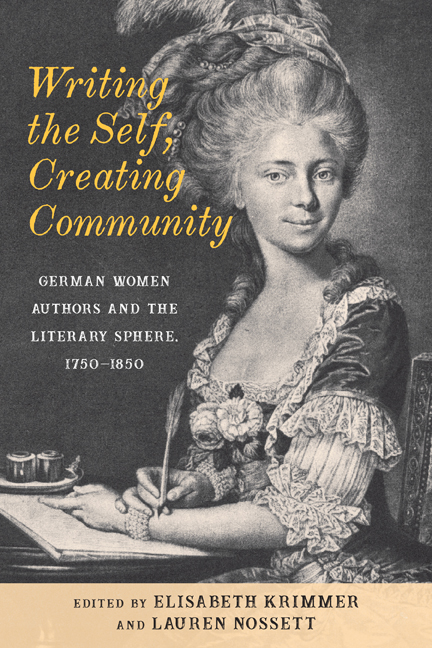Book contents
- Frontmatter
- Contents
- Acknowledgments
- Introduction
- Part I Writing a Community
- 1 Empowering Germany’s Daughters: On the Pedagogical Program and the Poetic Techniques of Sophie von La Roche
- 2 “Ich spreche lieber von guten Büchern”: Sophie von La Roche’s Concept of Female Authorship and Readership
- 3 Challenging Female Ideals: Marie-Elisabeth de La Fite’s Translation of Sophie von La Roche’s Geschichte des Fräuleins von Sternheim
- 4 Catherine II, Polyxene Büsching, and Johanna Charlotte Unzer: A Literary “Community of Practice”
- Part II Writing the Self
- 5 Ghostwriters: The Apparitional Author in Benedikte Naubert’s “Die Weiße Frau” (1792) and Sophie Albrecht’s Das Höfliche Gespenst (1797)
- 6 Vampirism Inverted: Pathology, Gender, and Authorship in Karoline von Günderrode’s “Die Bande der Liebe”
- 7 Wozu eine Amazonen—Literatur? Literary Creativity and Productivity in the Writings of Helmina von Chézy
- 8 Women Writers and the Märchenoma: Foremother, Identity, and Legacy
- Part III Writing toward Emancipation
- 9 The Illegitimacy of Authorship and the Legitimization of Passion in Agnes von Lilien
- 10 The Politics of the Female Body in Louise Aston’s and Fanny Lewald’s Writings through the Prism of the Romantic Theory of Sociability and Dialogue
- 11 Weibliche Irrsterne: Louise Otto and the Notion of Female Genius in Nineteenth-Century Germany
- Bibliography
- Notes on the Contributors
- Index
Part I - Writing a Community
Published online by Cambridge University Press: 01 October 2020
- Frontmatter
- Contents
- Acknowledgments
- Introduction
- Part I Writing a Community
- 1 Empowering Germany’s Daughters: On the Pedagogical Program and the Poetic Techniques of Sophie von La Roche
- 2 “Ich spreche lieber von guten Büchern”: Sophie von La Roche’s Concept of Female Authorship and Readership
- 3 Challenging Female Ideals: Marie-Elisabeth de La Fite’s Translation of Sophie von La Roche’s Geschichte des Fräuleins von Sternheim
- 4 Catherine II, Polyxene Büsching, and Johanna Charlotte Unzer: A Literary “Community of Practice”
- Part II Writing the Self
- 5 Ghostwriters: The Apparitional Author in Benedikte Naubert’s “Die Weiße Frau” (1792) and Sophie Albrecht’s Das Höfliche Gespenst (1797)
- 6 Vampirism Inverted: Pathology, Gender, and Authorship in Karoline von Günderrode’s “Die Bande der Liebe”
- 7 Wozu eine Amazonen—Literatur? Literary Creativity and Productivity in the Writings of Helmina von Chézy
- 8 Women Writers and the Märchenoma: Foremother, Identity, and Legacy
- Part III Writing toward Emancipation
- 9 The Illegitimacy of Authorship and the Legitimization of Passion in Agnes von Lilien
- 10 The Politics of the Female Body in Louise Aston’s and Fanny Lewald’s Writings through the Prism of the Romantic Theory of Sociability and Dialogue
- 11 Weibliche Irrsterne: Louise Otto and the Notion of Female Genius in Nineteenth-Century Germany
- Bibliography
- Notes on the Contributors
- Index
Summary

- Type
- Chapter
- Information
- Writing the Self, Creating CommunityGerman Women Authors and the Literary Sphere, 1750–1850, pp. 21Publisher: Boydell & BrewerPrint publication year: 2020

